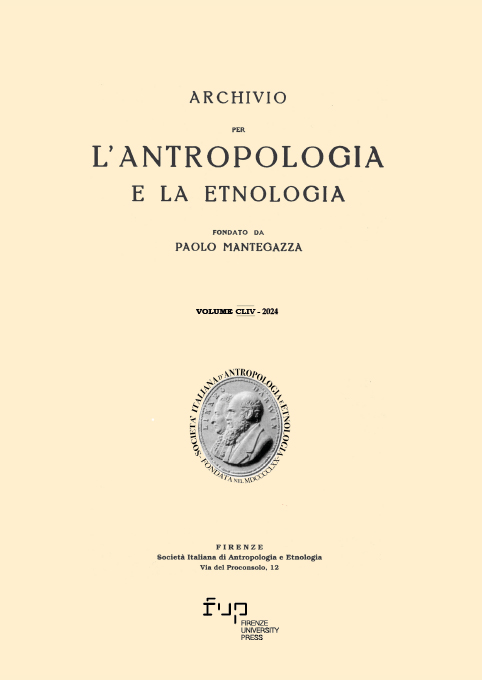Archivio per l'Antropologia e la Etnologia
Anthropology
Scopri l'Archivio per l'Antropologia e l'Etnologia. Risorse e studi approfonditi su cultura, società e tradizioni umane. Approfondisci la tua conoscenza.

Articles in this Journal
Ripensare l'Africa. La collezione di Ernesto Brissoni al Museo di Antropologia e Etnologia di Firenze
Among the thousands of objects from the African continent that came to the museum in the colonial era, Ernesto Brissoni's collection from the Congo deserves particular attention. Due to the quality of the works of the collection, it has repeatedly ar...
View Full Research
Tarquinia scomparsa: progetto di virtualizzazione 3D e analisi storico archeologica dell'ipogeo 1824 in località Calvario (Necropoli dei Monterozzi)
The archaeological record is often founded on the dynamic relationship between visible and invisible. A third possible dynamic, due the ravishes of time, is the «no longer visible». These three forces operated in the Calvario cemetery, a Hellenistic...
View Full Research
Le collane degli Ainu nella raccolta di Fosco Maraini al Museo di Antropologia di Firenze
Twenty years after the death of the great Florentine traveller Fosco Maraini (1912-2004) the Museum of Anthropology and Ethnology of the University of Florence reordered the material of his 1939-41 collection among the Ainu of Hokkaido. It is one of...
View Full Research
Severe gout and its treatment in an early 18th century Southern German monk: palaeopathology and archaeology
Following the restoration of the crypt of the Attel monastery in Southern Germany, the human remains of 16 out of 40 monks were exhumed and underwent anthropological and palaeopathological investigations. These skeletal remains were of individuals wh...
View Full Research
Analisi biologiche dei resti scheletrici di San Giuseppe da Copertino
We present the study of a peculiar case of the skeletal remains of an individual who was later recognised as a saint. According to the stories of his life he suffered a life of deprivation accompanied by physical phenomena that often considered as su...
View Full Research
Margaret Mead: un percorso antropologico contemporaneo
This article deals with some lesser-known key points of Margaret Mead's unconventional pathways of life and work. She raised many transcultural issues regarding female and male sexes that are still relevant and continue to animate current academic an...
View Full Research
The Secular Trend in Sicily. Proposal for Long Bones Measures and Statures open access databases
Human Stature is a widely used index of both individuals and populations. Stature is a sensitive measure of a series of factors including gender, age, social status, and environment. Human biologists and historians can use information on stature to b...
View Full Research
Mantegazza pop. Dall'Heracleum Mantegazzianum di Sommier & Levier a The return of the Giant Hogweed dei Genesis e oltre
Tuscan botanists and explorers Stéphen Sommier and Emile Levier during their trip to the Caucasus (1890) discovered a new plant species. In 1895 they named the species Heracleum mantegazzianum in dedication to their friend and anthropologist Paolo Ma...
View Full Research
Keepers of memories. Pre-Columbian Peruvian workbaskets in the Anthropology and Ethnology Museum of Florence
Pre-Columbian workbaskets were common inside burials, especially in coastal Andean regions. They mostly contained tools and raw materials related to textile production, but there were also some elements (e.g. Spondylus shells) not strictly connected...
View Full Research
Il serpente fra mito, rito e tradizione. Note a partire da due coltelli con motivi ofidici
This article aims to investigate the figure of the serpent through some of the most widespread myths and legends in various cultures. The study starts from the presence of two knives with ophidian motifs in the Museum of Anthropology and Ethnology in...
View Full Research
Forensic Facial Approximation and Archaeology: the case of Carmilla, the «Vampire of Venice»
In 2006 an archaeological excavation on Lazzaretto Nuovo Island (Venice, Italy) uncovered an anomalous grave dated by stratigraphic evidence to the 1576 plague pandemic. The human remains (ID 6) were interred with a brick placed in the mouth, indicat...
View Full Research
Analisi di resti scheletrici umani da siti risalenti al tardo Neolitico e all'età del Rame della provincia di Bergamo
Human osteological remains from Late Neolithic and Copper Age sites in the province of Bergamo were examined and reviewed. These derive from caves in the municipalities of Zogno (Buca del Tabàc, Grotta Pussù, Buca del Paier), Entratico (Buca del Corn...
View Full Research
The colonial face casts of Nello Puccioni: an emblematic case from Italy's fascist period
This article focuses, for the first time, on an in depth and systematic study of the face casts production of the Florentine anthropologist Nello Puccioni. The face casts are housed at the Museum of Anthropology and Ethnology of the University of Flo...
View Full Research
Top Blogs by Rating
Electro: The Art of Engineered...
By Sciaria
Electro-Pulse: Unveiling the U...
By Sciaria
The Geological Secret in Your...
By Sciaria
Favorite Blog
Beyond the Chart: The Nurse's...
By Sciaria
The Healing Power of "Ahhh": M...
By Sciaria
Unmasking the Macabre: The Dar...
By Sciaria





